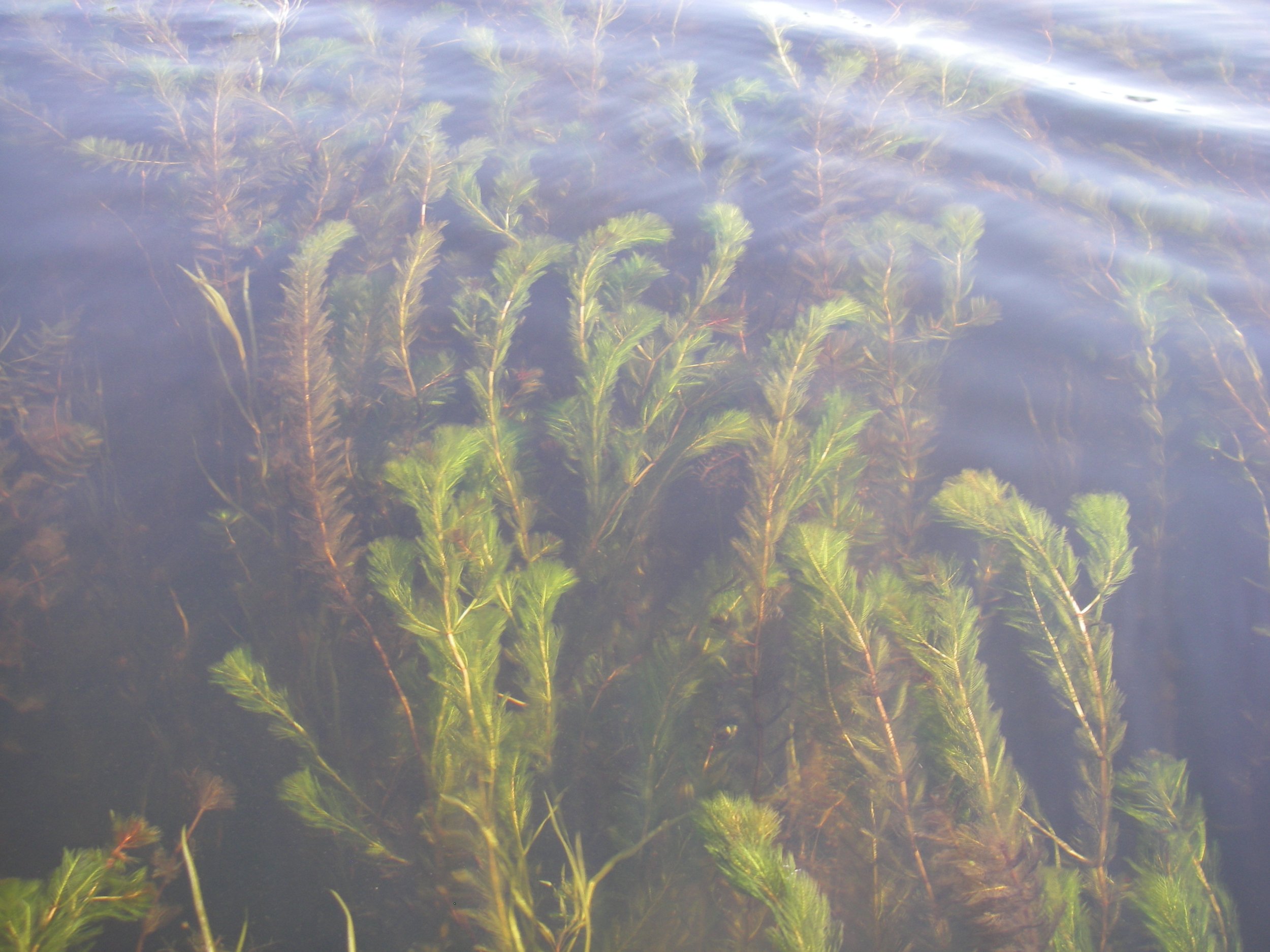What is Eurasian watermilfoil?
Eurasian milfoil is an invasive aquatic plant native to Europe, Asia and North Africa.
Why is it a problem?
It grows quickly and forms thick mats on the water’s surface, blocking sunlight from reaching other plants. This can lead to the decline of native plants that many aquatic species rely on for food and shelter. As native plants disappear, it harms fish and other wildlife that depend on them for survival. Additionally, these mats can change water quality by increasing sediment and reducing oxygen levels in the water, which further affects the health of the ecosystem.
The dense mats created by milfoil also make it harder for people to enjoy activities like boating, swimming, and fishing. The dense vegetation can tangle in paddles and boat propellers.
How does Eurasian watermilfoil spread?
The primary way Eurasian watermilfoil spreads is through vegetative reproduction. This spread is mainly through fragmentation of plant tips or through root expansion. With fragmentation, even a very small piece of this aquatic plant can float away, re-root and begin a new colony. It is easily fragmented and moved around within lakes by boats, or between lakes on boats and trailers. Eurasian watermilfoil milfoil can form thick, floating mats of vegetation, clogging the water and hindering recreation. It can grow in water 2-20 feet deep..
The Latest Update: What we are doing to fight the spread
First Detection
In early July, some plants were discovered in the northwest part of the lake and identified as possibly Eurasian Milfoil (EM), an invasive plant. Brian Greene, Program Director for the Adirondack Park Invasive Plant Program (APIPP), visited the lake to examine the area and take samples. Additionally, pictures were sent to Larry Eichler, formerly of the Darrin Freshwater Institute who has surveyed the lake for us. Both Brian and Larry believed the plants were native milfoil. Subsequently, the FLPOA Board agreed to have the lake surveyed professionally. Adirondack Research Co. was contracted to survey the lake from a boat for $3,000. This survey was conducted in the middle of August and no invasive plants were found.
Removal
On August 28, a FLPOA member while fishing reported suspected EM in the same location as in July. APIPP was contacted again, and a staff person was dispatched to review the plants and determined it was EM. Working with Brian, FLPOA President Bruce France contacted diving companies about harvesting the EM. Invasive Solutions (IS) Dive Company had an opening and was contracted to do the work at a cost of $7,855 for one week. At the end of September, IS Dive Co. spent 4 or 5 days on the lake harvesting a small amount of EM and their divers surveyed most of the lake.. Two other plants were found on the west side of the lake.
In early September, Bruce met with Town Supervisor John Maday and his predecessor Craig Leggett to define a plan for reimbursement for these expenditures through the taxing district and how to handle future expenses for surveys and any remediation. It was decided that a contract naming FLPOA as the management organization, like Loon Lake, would be drawn up to expedite the work. FLPOA will submit a budget for 2025 for approval by the town board.
Early detection, early action
Early identification and detection of Eurasian milfoil is crucial to preventing its spread and minimizing its impact on aquatic ecosystems.
The community’s proactive involvement and education played a key role in the early detection of Eurasian milfoil at Friends Lake. By educating residents on what milfoil looks like and encouraging them to keep an eye out for it, we were able to spot the invasive plant early, before it could spread significantly. This collective awareness has allowed for quick action to manage the infestation, minimizing the ecological impact on the lake’s ecosystem and preserving the area for recreation. The community’s efforts highlight how important local involvement and knowledge are in protecting natural resources.
Thanks to the swift response and early detection by the community, we are hopeful that we’ve successfully mitigated the spread of Eurasian milfoil at Friends Lake. By acting quickly and implementing effective management strategies, we’ve been able to keep the infestation under control (for now) preventing it from spreading further. While ongoing vigilance is necessary, we are optimistic that our proactive efforts have significantly reduced the risk further spread. More news will be forthcoming.
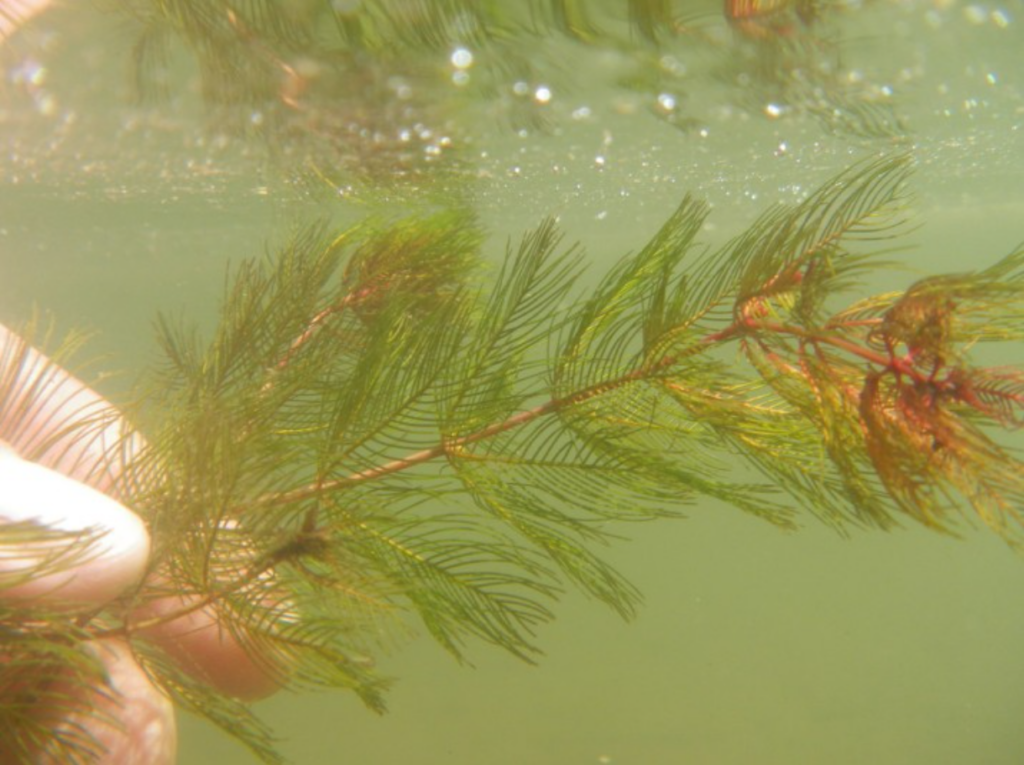
How to identify Eurasian milfoil
Eurasian milfoil has slender stems up to 2.5 m (8.2 ft) long. The plant is a perennial that grows under the water surface and has feather-like green leaves that circle the stem in groups of four or five. Eurasian milfoil blooms in late July and early August and has orange/red flowers that are 4–6 mm long. Flowers are produced in the leaf axils on a spike that can be 5–20 cm long, held vertically above the water surface.
Recognizing Eurasian Water Milfoil and Native Look-a-Likes
It can be hard to recognize the invasive Eurasian milfoil. Be aware of what similar-looking native plants can exist in the lake. These include:
- Northern watermilfoil (Myriophyllum sibiricum) – Rigid feather-like leaves forming a Christmas tree shape. The lower leaflets are usually quite long. • Leaves usually stiff when out of water. Leaves arranged in whorls (circles) of four to six around stem. • Usually seven to ten leaflet pairs per leaf.Stem is usually whitish or whitish green in color.
- Coontail (Ceratophyllum sp.) – Coontail is a free-floating aquatic plant without roots. It may be completely submersed or partially floating on the surface. The leaves are stiff and arranged in whorls. Each leaf is divided in a forked pattern. Leaf divisions have teeth along one margin. Leaves are crowded toward the tip of the stem creating the “coontail” appearance.
- Variable leaf milfoil (Myriophyllum heterophyllum) – A submerged aquatic plant with feather-like leaves, heavy stems, and small white flowers.
- Water Marigold (Megalodonta beckii) – Submersed leaves of water marigold are arranged in whorls and cut into many thread-like divisions. Leaves that grow above the water are not divided. Produces yellow, daisy-like flowers.
- Water Crowfoot (Ranunculus spp.) – Submersed plant with finely divided leaves. Leaves occur alternately along the stem, not in whorls. Small buttercup-like flowers are produced that stick up out of the water.
- Common Bladderwort (Utricularia vulgaris) – Submersed plant with finely divided leaves. Leaves are arranged alternately on the stem. • Most distinct characteristic is the presence of “bladders” or sacs to capture small animal life. Bladders are scattered on leaves or sepa- rate stems and may look like dark seeds.
- Common Waterweed, Elodea (Elodea canadensis) – Submerged plant with slender stems. Small lance-shaped leaves attach directly to the stem. • Leaves are in whorls of three, or occasionally two near the stem tips.
There are several distinguishing characteristics that can be used to differentiate between the the three primary species:
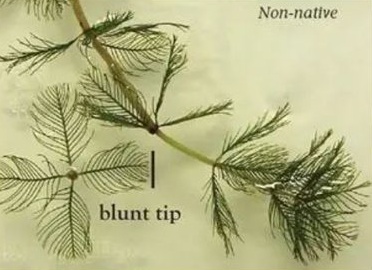
Eurasian Milfoil (Invasive)
Myriophyllum spicatum
- Usually 12-21 leaflet pairs per leaf
- Delicate, feather-like leaves
- Leaflets are mostly the same length
- Leaves arranged in whorls (circles) of 3-5 around each stem
- Leaves are limp when out of the water
- Stem is as thick or thicker than a pencil and is long and spaghetti-like
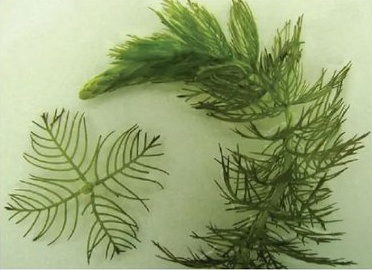
Northern Watermilfoil
Myriophyllum sibiricum
- Usually 7-10 leaflet pairs per stem
- Rigid feather-like leaves, form a Christmas tree shape
- Lower leaflets are usually quite long
- Leaves arranged in whorls (circles) of 4-6 around each stem
- Leaves are usually rigid when out of the water
- Stem is usually whitish or whitish-green in color
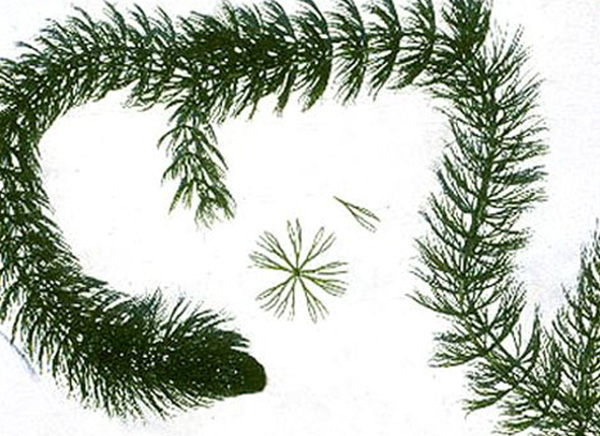
Coontail
Ceratophyllum demersum
- Color is medium to dark green. Leaves grow about a half inch long, spiny, and forked
- Leaves arranged in whorls of 5 to 12. Whorls are more closely spaced near the ends of the branches.
- Bushier towards the tip.
- It has a hollow stem and lacks true roots. Stems can grow up to 11 feet long and form large masses.
Highlighting the differences between the highly invasive Eurasian Watermilfoil (right jar) and the native Ceratophyllum, also known as “coontail” (left jar) pictured below:
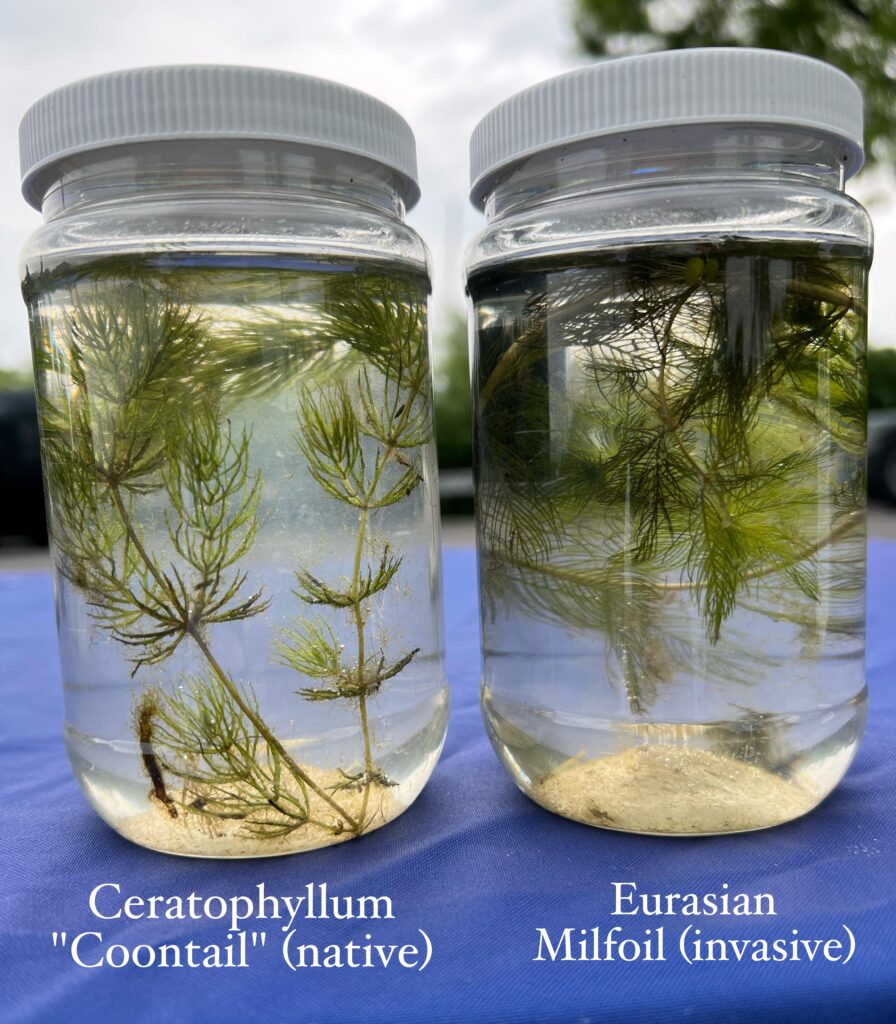
These plants can look pretty similar, especially when seen growing underwater.
The best way to tell the difference is in the leaflets: the Ceratophyllum’s leaflets can be seen branching and forking off of each other, whereas the Eurasian milfoil all branch from a single midline. The Ceratophyllum is also generally a bit bushier, especially when out of the water.
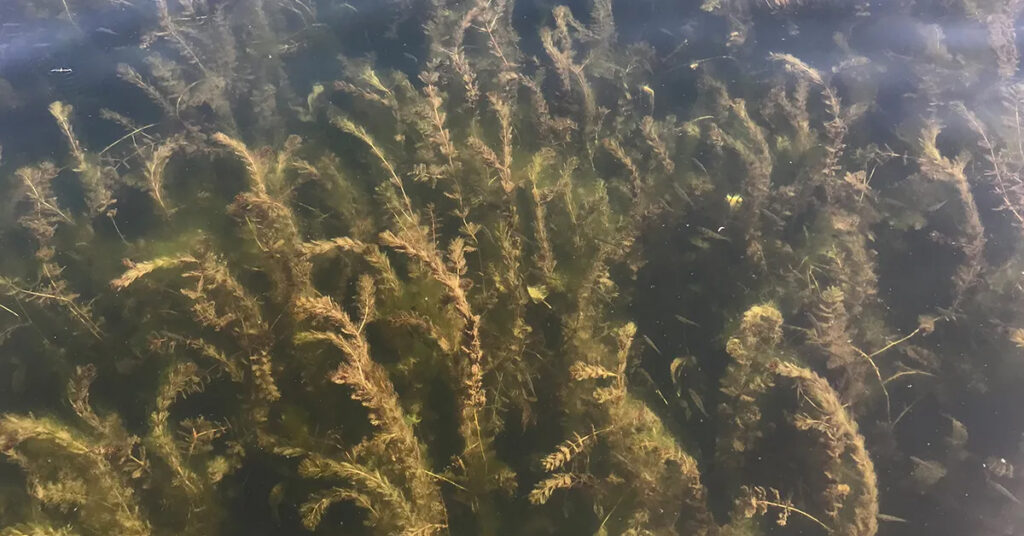
How to look for milfoil
Milfoil is generally found in water 3 to 10 feet deep. However, it is recommended that you extend your surveillance to 12 feet to be on the safe side. Since Friends Lake is generally shallow, the 12 foot depth line is typically a significant distance from the shore. This means that a single pass will not be sufficient, and usually 3 or 4 passes at different water depths will be required for a given stretch of shore line to be properly inspected.
You will quickly discover that unless conditions are right you will be unable to see well below the surface. Obviously you will want still water, but in addition you will want the sun to be close to the horizon, as it will be in the early morning and late afternoon. You may also find that partial cloud cover is helpful. It will also be extremely helpful to wear polarized sun glasses to reduce the surface glare.
While milfoil can be spotted from a kayak or canoe, a far better technique is for one person to stand in the bow of a powered boat while a second slowly pilots the boat throughout the area. This technique provides a higher view angle, which reduces the surface glare.
What you should do
People spread Eurasian watermilfoil primarily through the movement of water-related equipment. Plant fragments can get tangled on boats, trailers, motors, anchors and other water-related equipment. All it takes is a single plant fragment to start a new population.
- Avoid infested areas. Your propeller can break off fragments and spread the pieces to new areas. New plants can even grow from small pieces of the plant.
- Inspect your boat, trailer, and equipment after each use and clean all watercraft. Remove all plants, animals, and mud before moving to a new waterbody. Learn more about the process of clean, drain, dry (dry docks, lifts, swim rafts and other equipment for at least 21 days before placing equipment into another water body).
- If you think you’ve seen Eurasian watermilfoil report the sighting with this form or contact us directly with information of when and where you found the suspected Eurasian milfoil (GPS coordinates whenever possible) and photo evidence, if possible.
- ⚠️DO NOT PULL OR REMOVE suspected Eurasian milfoil from the bed of the lake, as pieces that fragment off the plant can help the invasive plant to spread.

